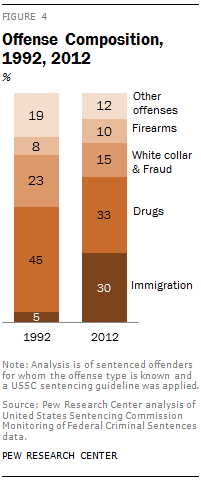The number of convictions in federal courts nearly doubled over the past two decades, from 36,564 to a record 77,506 in 2011, then falling to 75,867 in 2012.11 Most of that growth—54%—was attributable to an increase in immigration offense convictions. As a result, rapid growth in the number of immigration offense convictions changed the composition of offense convictions among federal sentenced offenders.
Immigration Offenses a Larger Share of Offenses

Close to half (48%) of the growth in the number of convictions in federal courts between 1992 and 2012 was driven by unlawful reentry cases alone, and 54% came from an increase in immigration offense convictions generally. By comparison, drug offenses (including possession, trafficking, and manufacturing) accounted for only 22% of the growth in the number of federal convictions over the same period.
The number of offenders convicted of unlawful reentry in federal courts increased from 690 cases in 1992 to 19,463 in 2012. In 2011, there were 21,489 federal unlawful reentry convictions—a record. The growth in unlawful reentry convictions has dramatically altered the composition of offenses in federal courts over the last two decades. In 1992, the largest offense type by far was drugs, accounting for 45% of convictions while immigration offenses accounted for 5% of offenses. By 2012, there were nearly as many immigration offense convictions as there were drug offense convictions. Immigration offenses made up 30% of offenses in 2012, a 26 percentage point increase over 1992. In 2012, drug convictions also accounted for 33% of offenses, down 12 percentage points since 1992.
All other offense types accounted for 36% of convictions in federal courts in 2012, down from 50% in 1992.
Types of Sentences

Under USSC sentencing guidelines, offenders sentenced in federal courts typically receive one of five sentences: a fine; a prison-only sentence; a prison sentence plus confinement conditions; a probation sentence plus confinement conditions; or a probation-only sentence. A prison sentence is the most common punishment imposed on offenders sentenced in federal courts. Nearly nine-in-ten (89%) federal offenders were incarcerated in 2012.
Among unlawful reentry offenders, 99% received a prison sentence in 2012, compared with 95% of drug offenders (including manufacture, distribution and possession), 93% of violent offenders, 95% of firearms offenders and 89% of offenders convicted of other immigration offenses. White collar and fraud, property and other offenders, by contrast, were less likely to receive a prison sentence, imprisoned in 75%, 46%, and 68% of cases, respectively.
Of those who received prison sentences, the average prison sentence in 2012 was 55 months, but the length of incarceration varied by offense type. Unlawful reentry offenders received nearly two years of incarceration (23 months) on average, while other immigration offenders received just over one year (15 months). Drug (71 months), other offense (78 months), violent (86 months), and firearms (87 months) offenders received the longest prison sentences. Property, fraud, and other offenders received 2.5 to 3.5 years of incarceration on average.




